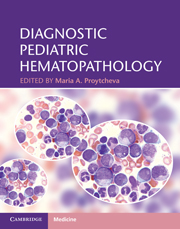Book contents
- Frontmatter
- Contents
- List of contributors
- Acknowledgements
- Introduction
- Section 1 General and non-neoplastic hematopathology
- Section 2 Neoplastic hematopathology
- 10 Chromosome abnormalities of hematologic malignancies
- 11 Expression profiling in pediatric acute leukemias
- 12 Myeloproliferative neoplasms
- 13 Myelodysplastic/myeloproliferative neoplasms
- 14 Myelodysplastic syndromes and therapy-related myeloid neoplasms
- 15 Acute myeloid leukemia and related precursor neoplasms
- 16 Hematologic abnormalities in individuals with Down syndrome
- 17 Precursor lymphoid neoplasms
- 18 Advances in prognostication and treatment of pediatric acute leukemia
- 19 The effect of chemotherapy, detection of minimal residual disease, and hematopoietic stem cell transplantation
- 20 Pediatric small blue cell tumors metastatic to the bone marrow
- 21 Pediatric mature B-cell non-Hodgkin lymphomas
- 22 Pediatric mature T-cell and NK-cell non-Hodgkin lymphomas
- 23 Hodgkin lymphoma
- 24 Immunodeficiency-associated lymphoproliferative disorders
- 25 Histiocytic proliferations in childhood
- 26 Cutaneous and subcutaneous lymphomas in children
- Index
- References
24 - Immunodeficiency-associated lymphoproliferative disorders
Congenital immune deficiencies, acquired immune deficiencies, and post-transplant lymphoproliferative disorders
from Section 2 - Neoplastic hematopathology
Published online by Cambridge University Press: 03 May 2011
- Frontmatter
- Contents
- List of contributors
- Acknowledgements
- Introduction
- Section 1 General and non-neoplastic hematopathology
- Section 2 Neoplastic hematopathology
- 10 Chromosome abnormalities of hematologic malignancies
- 11 Expression profiling in pediatric acute leukemias
- 12 Myeloproliferative neoplasms
- 13 Myelodysplastic/myeloproliferative neoplasms
- 14 Myelodysplastic syndromes and therapy-related myeloid neoplasms
- 15 Acute myeloid leukemia and related precursor neoplasms
- 16 Hematologic abnormalities in individuals with Down syndrome
- 17 Precursor lymphoid neoplasms
- 18 Advances in prognostication and treatment of pediatric acute leukemia
- 19 The effect of chemotherapy, detection of minimal residual disease, and hematopoietic stem cell transplantation
- 20 Pediatric small blue cell tumors metastatic to the bone marrow
- 21 Pediatric mature B-cell non-Hodgkin lymphomas
- 22 Pediatric mature T-cell and NK-cell non-Hodgkin lymphomas
- 23 Hodgkin lymphoma
- 24 Immunodeficiency-associated lymphoproliferative disorders
- 25 Histiocytic proliferations in childhood
- 26 Cutaneous and subcutaneous lymphomas in children
- Index
- References
Summary
Introduction
The immune system encompasses a complex network of cells and signaling molecules crucial to the defense against microorganisms and specific forms of cancer. It includes several different subsystems, and many cell types, such as lymphocytes, macrophages, granulocytes, and dendritic cells, each with their own functional subsets. The normal immune response involves a variety of processes, including cell activation and proliferation in response to a variety of ligands recognized by specific receptors, as well as mechanisms of termination of the response when it is no longer necessary. This complexity results in a large variety of diseases if the function of one or more of these cell types, and one or more of the processes essential to immune homeostasis, is affected. As a result, immunodeficiencies with a wide range of clinical manifestations, from complete inability to mount a proper response to infections, to uncontrolled ongoing immune responses, develop. This chapter addresses lymphoproliferative disorders that are a consequence of immunodeficiency.
Immunodeficiency is associated with an increased risk of benign and malignant lymphoproliferative diseases (LPDs). These may result from aberrant reactions to normal stimuli, the complete inability to terminate an immune response, or accumulation of genetic defects in the immune cells. Biopsies from patients with immunodeficiencies pose a challenge to the pathologist, due to the aberrant make-up of the immune response in this context, the different nature of the lymphoproliferations, and the altered morphology of lymphomas arising in this setting, when compared to immunocompetent hosts.
- Type
- Chapter
- Information
- Diagnostic Pediatric Hematopathology , pp. 484 - 503Publisher: Cambridge University PressPrint publication year: 2011
References
- 1
- Cited by



